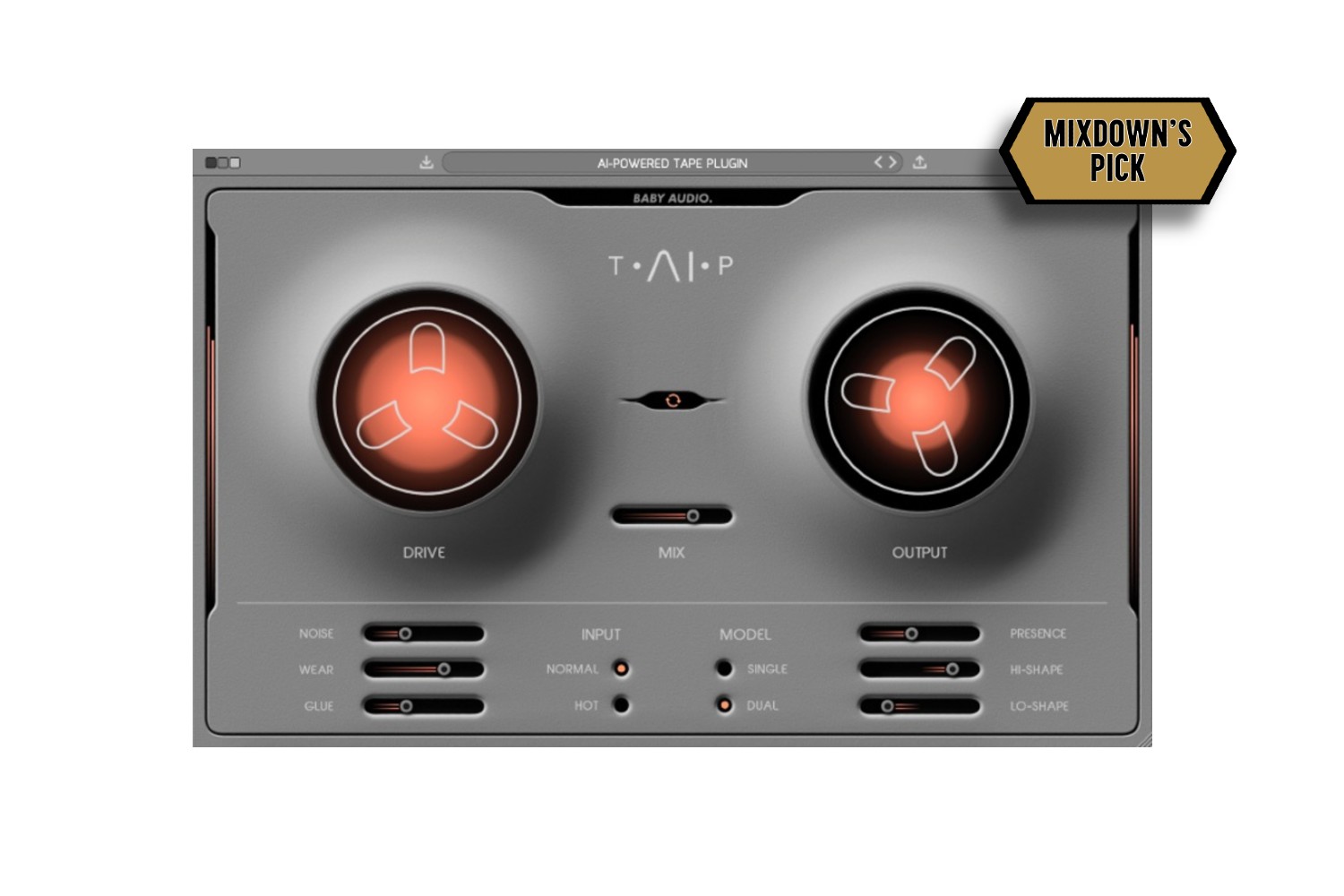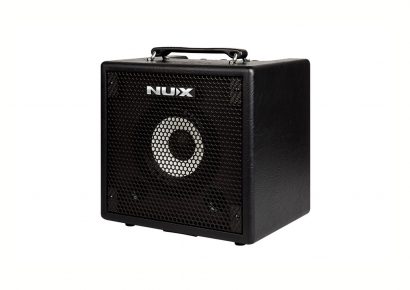Baby Audio | RRP: US$69
‘There’s just something about Tape’ is a phrase so often thrown around, that it has well and truly crossed into cliche at this point. Not that this isn’t ultimately a truism (rest assured, there definitely is something about Tape—many things in fact which the Baby Audio TAIP plugin addresses), but more an indication of the kind of difficulty the audio industry has traditionally had in articulating this point any further.
Regardless of whether you are an old head dusting off your much loved Ampex ATR 2 inch or an ITB zoomer who’s never actually seen a physical tape machine in the real world, one thing that we can all agree on is that tape and digital are very different beasts, both in sonics and in workflow.
Catch up on all the latest music gear reviews here.
For most, the gold standard exists somewhere in between, a way of replicating tape’s inherent musicality and forgiving nature with all the convenience and ease of editing that typifies the modern DAW setup. This is exactly where Baby Audio’s new AI powered tape emulator, TAIP positions itself, and it proves an awesome addition for anybody requiring an antidote to the icy coldness of binary.
Contrary to popular belief, part of the aforementioned ’special something’ commonly associated with tape isn’t necessarily an inherent drop in fidelity (in fact many higher-end Tape formats offer fidelity on par with what we are used to in the modern digital world). It’s more about how the sympathetic character of the medium itself ushers in an inherent musicality—one that works in concert with other stops in the recording chain to connect (glue) disparate sources, increase steady-state volume properties (fatten) and round off (flatten) harsher transients, into something better suited to the overall composition.
Compare the above to a common digital recording chain featuring a lightning-fast, but sonically harsh condenser mic feeding into the kind of transparently linear stock preamps found on most consumer interfaces (which we are running at 192kHz for no discernible reason) and you kind of understand that we are talking about a different end game here.
One is all about committing to well-considered musical decisions through every step of the recording process and the other is about casting as wide a net as possible at the front end, even if only part of this capture is usable in the grand scheme, then trying to process our way out of it after the fact.
And then of course there is the saturation. That beautifully fragile and wonderfully flawed harmonic saturation that digital has had such a hard time nailing up unto this point.
In the context of modern digital recording, somethings got to (for)give and this is precisely what makes Baby Audio’s new AI-powered TAIP Saturation plugin such an awesome and intriguing prospect for anyone looking to breathe subtle life into their digital works, whilst also having an excellent creative tool at their disposal for when things get freaky.
Sympathetic, malleable and above all else, incredibly musical, the Baby Audio TAIP plugin offers one of the finest sounding audio engines we’ve ever encountered for this kind of thickening and sweetening, with enough flexibility and scope in the parameters to pull off some serious sonic weirdness when required.
More than just a PR gimmick, the decision to incorporate AI into the design of TAIP (in this circumstance, to essentially decipher the invisible nuances of complex analog circuits) is an innovation that is sure to open up all kinds of experimentation and growth within the digital audio sector.
By utilising advanced AI algorithms to essentially reverse engineer the plugin by analysing the finished audio first and working back from there (as opposed to traditional DSP modelling), the Baby Audio team have landed on something truly special here, with the TAIP plugin offering some of the finest, idealised, ‘analogesque’ Saturation sounds you are ever likely to find in the digital realm.
True to form, the graphic interface found on TAIP follows the brands well developed visual sense, as is evident on other recent Baby Audio offerings such as the ‘Smooth Operator’ with its dulcet pastel colourway or ‘Spaced Out’s’ highly stylised ode to 80’s sci-fi.
This time around the look is post 2000s futurist, with a sprinkling of early ’90s cassette culture thrown in for good measure. The illuminating Drive and Output functions are a particularly nice touch that serves as an important visual aid regarding the amount of saturation being applied at any given moment.
More than just a pretty face, Baby Audio’s TAIP is an excellent tonal shaping and sound design tool with a highly organic and flexible feature set that allows for plenty of creativity and control at the mix stage.
The auto gain function is a super handy way of keeping track of our level matched listening habits, which is particularly important in the context of harmonic saturation. After all it’s nice to know what the plugin is actually doing without any of the inherent biases that come from discrepancies in playback volume.
Wear (which is a sort of hybrid of Wow, Flutter and various other side effects generally associated with Tape degradation) is a great way to add subtle modulation and warble effects to your highly saturated sound. This has the effect of providing perfect periodic grit at low levels or full-blown Boards of Canada style distortion when cranked up. There is also a Noise function which controls the amount of tape hiss evident in your saturated sound, for added authenticity.
The Lo-shape and Hi-shape parameters are an extremely useful and pleasant sounding addition to the plugin’s already expansive tonal shaping capabilities. The tactfulness and naturalness of these aforementioned bias shapes provides an awesome starting point from which to work from.
With plenty of interactivity between the plugins internal parameters and the tastefulness of the pre-drive bias, every combination of Hi and Lo brings its own distinctive vibe, in turn providing a saturation palette for basically any application.
There is also the option for single or dual modes which emulates our source being passed through one or two tape machines thus adding further harmonics and saturation/drive characteristics to our signal.
Perhaps most importantly, is the way in which Baby Audio TAIP never veers into harshness or any kind of overt digital clipping, even when pushed to its limits. Just like the tape machines of old, it continues to heap on the harmonic richness and fire, without ever descending into digital camo mode, which is a sign of an extremely well oiled audio engine. In terms of sonics, it is truly top-shelf and the extremely affordable price-point means a borderline instant return on investment for anyone in need of some artful obfuscation.
For us millennium Babies born into an already 24-bit digital world, our understanding of tape comes not from a nostalgic hands-on account with the recording medium itself (to be honest even hearing stories about people manually cutting tape is enough to give me immediate anxiety), but more as a creative effect, to shade and shape our isolated, static recordings with subtle warmth, saturated harmonics, light compression and even the occasional bit of harder edged musical distortion when required. For this, you’d be hard-pressed to find anything better suited to the mission at hand than Baby Audio’s new TAIP plugin. It truly is one of the best plugins in recent memory for this kind of multi-purpose harmonic treatment.
If Baby Audio TAIP’s stellar recreation of analog saturation sounds are anything to go by, AI might well be the answer to truthfully replicating the sonic musicality of analog in the digital domain once and for all. Watch this space.
Check out TAIP via Baby Audio’s website.

